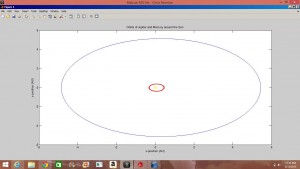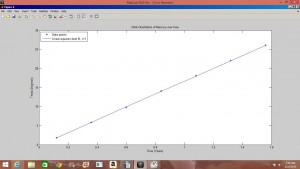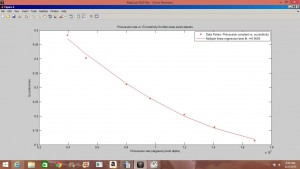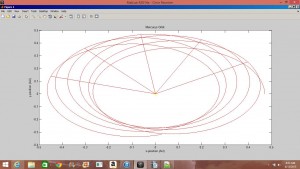The precession of Mercury is caused by the gravitational effects of the other planets (Jupiter contributing the most) and the general relativistic effects of the Sun. In the first part of my project I set about achieving the value of the precession of Mercury using the Euler-Chromer method to simulate Mercury’s orbit and least-square linear fits of ![]() and precession rate vs.
and precession rate vs. ![]() . I achieved a value of
. I achieved a value of ![]() , with a percent error deviation of 10.39 from the true value,
, with a percent error deviation of 10.39 from the true value, ![]() .
.
In the second part of my project, I let the eccentricity of the orbit of a Mercurian-sized body vary in its orbit in order to observe eccentricity’s effect on the precession rate. I determined that precession rate is inversely proportional to ![]() . The values of
. The values of ![]() and eccentricity I used are included in a table attached to this post.
and eccentricity I used are included in a table attached to this post.
This past week I experimented with 3-body systems in order to determine the effect of Jupiter on Mercury’s precession. Using the Euler-Chromer method I was able to successfully model a Jupiter-Mercury-Sun system, but only when the Sun’s position and velocity were held at 0.
For the case in which the Sun was to be given an initial position and velocity, I input parameters that should have allowed the center of mass to remain constant, however the graphs showed the Sun escaping from the solar system. Unfortunately I’m not sure how this error occurred, however I am convinced that this model is necessary to determine Jupiter’s effect on Mercury’s precession, as I was unable to achieve the correct value with the model in which the Sun’s position and velocity were held constant.
Link to Code:
https://docs.google.com/a/vassar.edu/document/d/1DrX3F-mnJsyuq8FPltXRY8aCFyNxQvoUGUG_BoIpiBE/edit?usp=sharing
Link to Eccentricity Data:
https://docs.google.com/a/vassar.edu/spreadsheets/d/1YNlhVNkyhy-arqPQW5dAoME6pCHRKIlXpKaZ6bisG-s/edit?usp=sharing






